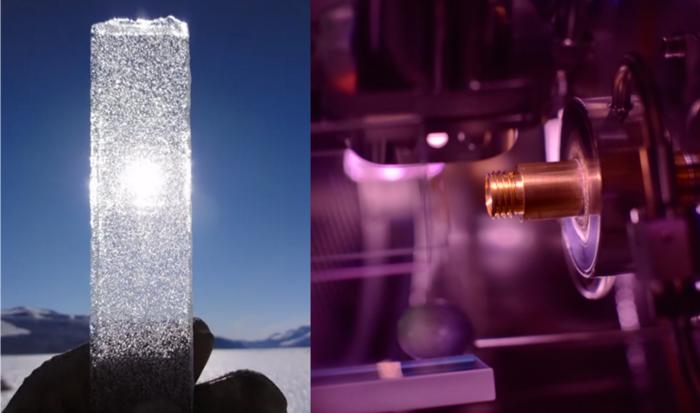A groundbreaking advancement in paleoclimatology has recently been achieved by a collaborative team led by Professors Zheng-Tian Lu and Wei Jiang at the University of Science and Technology of China (USTC). This innovative work introduces a novel technological framework termed All-Optical Atom Trap Trace Analysis, which has positioned krypton-81 dating of ancient Antarctic ice into a new paradigm. As evidenced in their study published in Nature Communications, the researchers have successfully determined the ages of 1-kilogram samples of ice extracted from the Antarctic, a feat previously hindered by technological limitations and the minuscule amount of krypton-81 available in such samples.
The significance of ice cores—invaluable repositories of climate data—is underscored by their ability to offer insights into Earth’s climatological history, often extending back over millions of years. Deep ice cores drilled from locations such as Antarctica and the Greenland ice sheet capture critical periods of climatic transition, revealing climatic patterns that contemporary studies strive to understand. However, until now, accurately dating these ice cores, particularly the basal ice at the core’s bottom, has posed a significant challenge due primarily to geological disturbances that can obscure stratigraphic layers.
Krypton-81 presents itself as an enticing isotopic tracer for dating such ancient ice due to its rarity and longevity, which enables researchers to examine ice samples that might hold records from impressive periods—up to 1.5 million years. The inherent challenges arise from the limited presence of krypton-81 atoms in a typical kilogram of ice, which can often be measured in mere hundreds. Overcoming this limitation requires cutting-edge detection techniques capable of identifying these scarce isotopes without compromising the integrity of the ice samples.
In a formidable step towards resolution, the USTC research team pioneered an all-optical detection method in 2021. This technique has witnessed significant evolution over the past four years, thanks to continuous improvements to facilitate the analysis of authentic ice core samples. A key innovation lies in their creation of a high-brightness, narrow-bandwidth vacuum-ultraviolet light source, specifically designed to effectively convert krypton into metastable atoms. The ramifications of this technology are notable. By drastically reducing cross-contamination of samples and enabling non-destructive measurements, the team has successfully condensed the necessary sample size to a mere 100 nanoliters of krypton gas, equating roughly to 1 kilogram of ice, while extending the upper dating limit of the technique to 1.5 million years.
The implications of this scientific endeavor breathe new life into the study of paleoclimate dynamics. With the krypton-81 dating technique now feasible for smaller ice samples, a more comprehensive understanding of ancient glacial movements becomes achievable. Researchers involved in this project are already eyeing the potential of systematically applying this newly refined method not only to ice from Antarctic glaciers but extending to Greenland ice sheets and the Tibetan Plateau. The exploration of ice core samples from these varied regions opens myriad research possibilities, including examining the stability of the Greenland ice sheet, outlining the development timelines of Tibetan glaciers, and uncovering ancient ice spanning critical climatic transitions such as the Mid-Pleistocene Transition.
This collaborative achievement exemplifies the confluence of resources and skills across disciplines, blending the realms of quantum physics and earth science in the pursuit of more grounded scientific insights, particularly concerning climate change and its historical patterns. As researchers embrace this new dating approach, the opportunity to unlock further chapters of Earth’s climatic history and advance our understanding of current climatic changes becomes palpable.
The journey from laboratory innovation to real-world application in this study not only demonstrates the prowess of the USTC team but also promises to ignite further collaborations across global research communities. As new partnerships emerge, the collective scientific endeavor has the potential to significantly enrich the field of glaciology and paleoclimate research, fostering an expansive dialogue centered on climate science and its implications for a changing world.
Efforts to understand our planet’s historical climate are more crucial than ever, particularly as contemporary scientists grapple with ongoing shifts in climate patterns. The findings derived from this research underscore the value of advanced dating techniques and their ability to inform present and future climate models. By delving deeper into Earth’s climatic record, researchers remain on a trajectory to enhance our understanding of climate variability over significant timescales, ultimately illuminating the resilience and vulnerability of Earth’s ice-covered regions amid global climatic changes.
In conclusion, the remarkable work executed by the USTC team paves the way for the next generation of paleoclimate research. By harnessing the properties of krypton-81, the scientific community now stands better equipped to reconstruct climactic epochs, poised to unlock secrets buried within the Earth’s icy archives.
Subject of Research: Krypton-81 dating of Antarctic ice
Article Title: 81Kr dating of 1 kg Antarctic ice
News Publication Date: 12-May-2025
Web References: Nature Communications Article
References: Phys. Rev. Lett. 127, 023201 (2021)
Image Credits: Image by Prof. ZHENG’s team
Keywords
Paleoclimatology, Krypton-81, Antarctic Ice, Climate Change, Earth Sciences, Glaciology, Climate Science, Ice Cores.
Tags: All-Optical Atom Trap Trace Analysisancient ice dating techniquesAntarctic ice core analysisclimate data repositoriesclimatic transition periodsgeological disturbances in ice coresisotopic tracers for datingKrypton-81 datingpaleoclimatology advancementsstratigraphic layer challengesUniversity of Science and Technology of ChinaUSTC research breakthroughs





